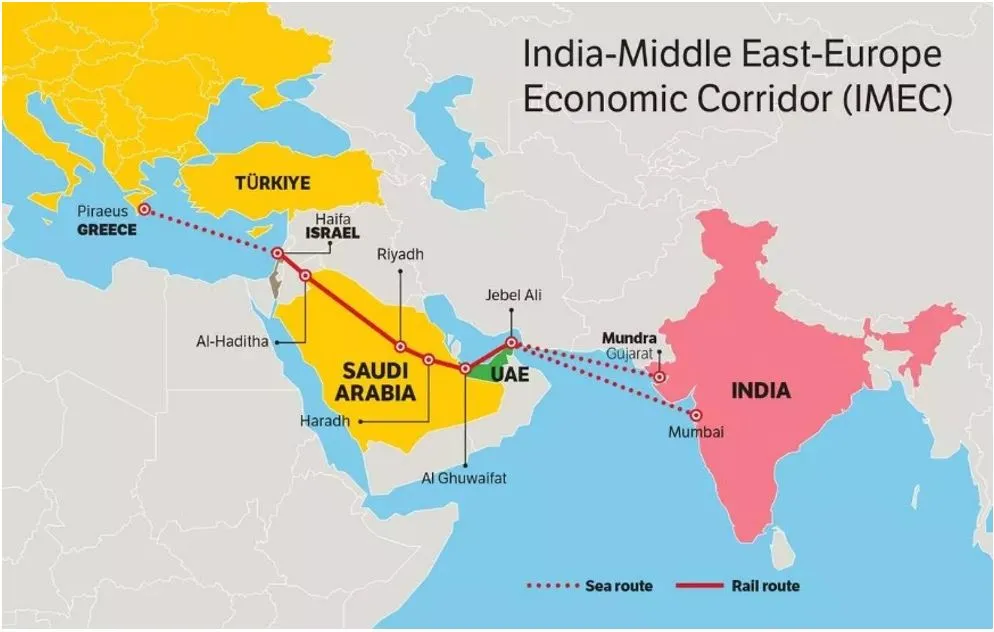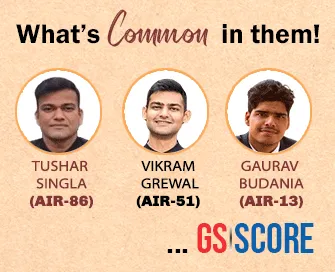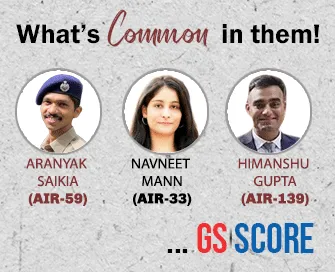

13th February 2025 (13 Topics)
Mains Issues
Context
A petition is being heard by the Supreme Court asking for lifetime bans on people convicted of crimes from running for elections. Right now, people convicted of crimes are disqualified from contesting elections for six years after they are released from jail, but the petitioners argue this isn't enough. They want to ban them from running forever.
What is the current petition asking?
- The petitioners want a lifetime ban on anyone convicted of a crime from running for elections. They argue that if a person convicted of a crime isn’t fit for even a junior government job, they shouldn’t be able to become a lawmaker after serving their sentence.
- The right to stand for election is not a fundamental right. So, putting some restriction on who can and cannot stand in the election, is not a suppression of ‘freedom of speech’ or ‘right to livelihood’.
- Government’s stand: However, the government says that MPs and MLAs aren’t bound by the same rules as government workers, so the six-year disqualification period is enough.
Criminalization of Politics:A report showed that 46% of MPs elected in 2024 have criminal charges, and 31% face serious charges like rape, murder, or corruption. This raises concerns about the integrity of lawmakers. |
Reasons for the criminalization of politics in India:
- Politician-Bureaucracy Nexus: The close, often corrupt, relationship between politicians and government officials has fueled criminalization in politics.
- Political Interference in Administration: Politicians' interference in governance increases corruption, leading to criminal involvement in politics.
- Caste and Religion: Caste and religious considerations influence promotions and policies, further encouraging corruption and criminal behavior.
- Party System: Political parties often make empty promises to win elections, using unethical means, which fosters criminal politics.
- Economic Issues: Poverty, illiteracy, and underdevelopment create conditions that allow criminal elements to thrive in politics.
- Corruption: Systemic corruption has become ingrained in the political and administrative system, fueling criminal behavior.
- Election Commission Loopholes: The Election Commission’s limited role in regulating candidates' backgrounds has allowed criminals to enter politics.
- Failure of Justice and Rule of Law: A lack of trust in the justice system and the rule of law has weakened the effectiveness of democratic governance.
Ramifications of criminals entering India’s political sphere
- The criminalization of politics threatens the integrity of the legal system.
- The presence of politicians with criminal histories jeopardizes the credibility of the legislative process.
- Politicians with criminal histories may try to sway laws to their advantage by using their power. This may be shown in how resources are distributed, laws are put into effect, and benefits are distributed.
- The criminalization of politics is threatening the fundamental underpinnings of democracy and the rule of law.
What are the laws about this?
- Section 8(3) of the Representation of the People Act (RP Act, 1951): If someone is convicted of a crime and sentenced to 2 years or more in prison, they can’t run for elections for six years after they’re released from jail.
- Section 8(1): If someone is convicted of serious crimes (like rape or corruption), they are permanently banned from running, no matter the length of their sentence.
- Section 11 of the RP Act: This law lets the Election Commission (EC) reduce or remove the disqualification period for certain people, allowing them to run for elections earlier.
SC Judgments favouring decriminalisation of politics
|
PYQQ. It is often said that ‘politics’ and ‘ethics’ do not go together. What is your opinion in this regard? Justify your answer with illustrations. (2013) |


Mains Issues
Context
A popular digital content creator is under investigation for allegedly making obscene remarks (under Section 296 of the Bharatiya Nyaya Sanhita (BNS), 2023), raising concerns about the balance between freedom of speech and the regulation of obscene content in the digital space.
Which laws govern obscenity in online content?
- Bharatiya Nyaya Sanhita (BNS), 2023, Section 294: This law criminalizes the sale, import, export, advertisement, or profit from obscene material, including the display of content in electronic form.
- Obscene material is defined as material that is lascivious, appeals to prurient interests, or has the potential to deprive and corrupt individuals likely to view it. This could include excessive sexual content or content harmful to public morals.
- Punishments under Section 294 include up to 2 years imprisonment and a fine of up to Rs. 5,000 for first-time offenders.
- Information Technology Act, 2000, Section 67: This provision specifically addresses the publishing or transmitting of obscene material online.
- The definition of obscene material under this law is similar to the BNS, but the penalties are more severe: up to 3 years imprisonment and a fine up to Rs. 5 lakh for first-time offenders.
Judicial Evolution of Obscenity Laws in India:
- Key Early Case: The 1964 Supreme Court ruling in Ranjit D Udeshi v. State of Maharashtra declared the book Lady Chatterley’s Lover obscene under Section 292 of the IPC, applying the Hicklin test, which defined obscenity based on its potential to corrupt vulnerable individuals, such as children.
- The Hicklin Test: The test, originating from the British case Queen v. Hicklin (1868), set a low threshold for obscenity, focusing on whether material could corrupt the most impressionable people.
- Shift in Standards: In the 1950s-60s, both the UK and US moved to context-based tests:
- UK: The 1959 Obscene Publications Act required assessing works as a whole.
- USA: The 1957 Roth v. United States case introduced the "community standards" test, evaluating material based on the perspective of an average person.
- India's Adoption of the "Community Standards" Test: In Aveek Sarkar v. State of West Bengal (2014), the Indian Supreme Court moved away from the Hicklin test, adopting the "community standards" approach.
- It ruled that obscenity should be judged by contemporary societal norms, considering the entire work, and quashed obscenity proceedings against a magazine that published a nude image.
Freedom of Speech VS Obscenity:
- Article 19(1)(a) guarantees freedom of speech, but this right is subject to reasonable restrictions under Article 19(2), including protection of public morality.
- In Kamla Kant Singh vs. Bennett Coleman (1987), the Supreme Court balanced free speech and public morality, ruling that explicit sexual content did not meet the threshold of obscenity based on contemporary community standards.
PYQQ: What do understand by the concept “freedom of speech and expression”? Does it cover hate speech also? Why do the films in India stand on a slightly different plane from other forms of expression? Discuss. (2014) |


Mains Issues
Context
Domestic workers in India, largely comprising women and migrants, face widespread exploitation, abuse, and lack of legal protection. Despite being a crucial part of the workforce, their rights are often ignored, and they are vulnerable to mistreatment in private households.
Domestic Workers in India
- Under the ILO Convention 189, a domestic worker is “any person engaged in domestic work within an employment relationship”.
- According to official statistics, India has 75 million domestic workers, including three million women.
- But the International Labour Organization (ILO) estimates the true numbers to be between 20 and 80 million.
Issues Faced by Domestic Workers in India
- Exploitation and Abuse: Domestic workers are often subjected to physical, emotional, and sometimes sexual abuse. In many cases, these workers are paid extremely low wages, with some even being denied their dues.
- Lack of Legal Protection: Domestic work in India is not classified as formal employment, so domestic workers are excluded from the benefits and protections available to workers in the formal sector, such as minimum wages, social security, paid leave, or the right to unionize.
- Caste-Based Discrimination: Many domestic workers belong to lower castes, especially the Dalit community. This social hierarchy further entrenches discrimination, with workers being subjected to degrading treatment due to their caste.
- Lack of Recognition: Domestic workers are often not registered, making it difficult to identify them or track their employment history.
- Gender Inequality: The majority of domestic workers in India are women, and the sector is heavily gendered. This creates a scenario where women are disproportionately vulnerable to abuse, exploitation, and low wages.
Reasons Behind the Issues
- Absence of Formal Regulations: There are no comprehensive laws governing the sector.
- Socio-cultural Attitudes: The perception that domestic work is unskilled or "lower-status" perpetuates poor working conditions and social stigma.
- Fragmentation of the Workforce: The domestic workforce is scattered across individual homes, with workers often moving between multiple employers. This fragmentation makes it difficult to implement policies or raise awareness about their rights.
India’s Stand on Domestic Workers
- National Policy on Domestic Workers (2019): In 2019, the Indian government proposed a National Policy for Domestic Workers, aimed at improving their living and working conditions. However, the policy has not been fully implemented, and many domestic workers continue to work without any legal protection.
- State-level Protections: Several states have introduced minimum wage laws for domestic workers, such as Karnataka, Kerala, and Tamil Nadu. However, their implementation has been inconsistent, and workers often remain unaware of these provisions.
- International Commitment – ILO Convention 189: India has yet to ratify the International Labour Organization’s (ILO) Convention 189, which aims to provide domestic workers with the same rights as other workers.
- Despite voting in favor of the convention in 2011, India has not fully implemented the provisions, further perpetuating the vulnerability of domestic workers.
Government Schemes and Initiatives
|
PYQQ. Distinguish between ‘care economy’ and ‘monetized economy’. How can the care economy be brought into a monetized economy through women empowerment? (2023) |


Mains Issues
Context
The AI Action Summit in Paris saw the signing of a joint statement on Inclusive and Sustainable AI by 58 countries, including India, China, Brazil, France, and Australia. However, the United States and the United Kingdom did not sign the statement.
Key Points from the Summit Declaration:
The countries signed a Pledge for a Trustworthy AI in the World of Work, a nonbinding declaration. The declaration outlined six main priorities:
- Promoting AI Accessibility: Reducing digital divides and ensuring AI is available to all.
- AI Safety & Trust: Ensuring AI is ethical, transparent, safe, and secure.
- Fostering AI Innovation: Encouraging the development of AI while avoiding monopolies.
- Shaping the Future of Work: Ensuring AI contributes to sustainable economic growth and better labor markets.
- Sustainability: Promoting AI development that is sustainable for people and the planet.
- International Cooperation: Encouraging global coordination on AI governance.
India’s Role & PM Modi’s Speech:
- India and France co-chaired the summit.
- PM Modi emphasized:
- Open-source AI: Supporting open-source models to avoid biases and better reflect India's diverse languages and culture.
- AI Sustainability: Addressing the high energy needs of AI, with a focus on using clean energy to power AI development.
- AI and Jobs: Optimism about AI creating new job opportunities by skilling and reskilling workers to adapt to new job roles.
PYQQ. With the print state of development, Artificial Intelligence can effectively do which of the following? (2020)
Select the correct answer using the code given below:
Solution: (d) |


Prelims Articles
Context
Prime Minister Narendra Modi and French President Emmanuel Macron agreed the two countries should work more closely on building the India-Middle East-Europe Corridor (IMEEC).
About
- The IMEEC is a multilateral initiative to revive ancient trade routes and forge new economic ties between regions that have historically been interconnected through commerce, culture and collaborative diplomacy.
- It aims to integrate India, Europe, and the Middle-East through UAE, Saudi Arabia, Jordan, Israel and the European Union.
- The corridor will connect western India, the UAE’s Ras Al Khaimah, Saudi Arabia, Jordan, Israel, and then continue to Europe across the Mediterranean Sea.
- The IMEEC will have two separate corridors –
- East Corridor connecting India to the Gulf
- Northern Corridor connecting the Gulf to Europe
- Ports in the India-Middle East-Europe Economic Corridor (IMEC)
- India: Mundra Port (Gujarat), Kandla Port (Gujarat), Jawaharlal Nehru Port Trust (Navi Mumbai)
- Middle East: Fujairah Port (UAE), Jebel Ali Port (UAE), Abu Dhabi Port (UAE), Dammam Port (Saudi Arabia), Ras Al Khair Port (Saudi Arabia)
- Railway Line: The railway will link Fujairah Port (UAE) to Haifa Port (Israel), passing through Saudi Arabia (via Ghuwaifat and Haradh) and Jordan.
- Israel: Haifa Port (Israel)
- Europe: Piraeus Port (Greece), Messina Port (Southern Italy), Marseille Port (France)
- The corridor intends to enhance connectivity, increase efficiency, reduce costs, secure regional supply chains, increase trade accessibility, generate jobs and lower greenhouse gas emissions, resulting in a transformative integration of Asia, Europe and Middle East.
- The rail and shipping corridor is part of the Partnership for Global Infrastructure Investment (PGII).
- It is a collaborative effort by G7 nations to fund infrastructure projects in developing nations.
- PGII is considered to be the bloc’s counter to China’s Belt and Road Initiative.



Prelims Articles
Context
The Parliament’s Public Accounts Committee has directed the government to review the existing toll tax rules, especially in light of the rise in vehicular traffic and the failure of concessionaires to comply with their contractual obligations.
Current Toll Tax System:
- Toll taxes on National Highways are currently levied based on the base rate of fee per kilometer as prescribed in the National Highways Fee Rules, 2008.
- In India, the tolling is generally under an open system, wherein fee payable is a fixed amount based on the length of stretch under one project
- At present, there are over 1,000 toll gates in India.
- Currently, the FASTag system is being used to deduct toll at plazas.
- FASTags were made mandatory for all four-wheelers from February 2021.
- It is an electronic toll collection system in which ‘Radio Frequency Identification’ (RFID) technology is used to make toll payments.
- The FASTag contains a small RFID chip that communicates wirelessly with toll booth readers.
- Issues:
- Increase in Vehicular Traffic: Since 2008, there has been an exponential increase in the number of vehicles using National Highways.
- Non-compliance by Concessionaires (private companies managing toll plazas)
- Despite the introduction of FASTags (electronic toll collection system), long traffic jams at toll gates continue to be a problem.
Fact Box:National Highway Authority of India (NHAI)
|
PYQQ1: With reference to India's projects on connectivity, consider the following Statements: (2023)
How many of the above statements are correct?
Solution: (d) Q2. Consider the following pairs: (2014) National Highway : Cities connected
Which of the above pairs is/are correctly matched?
Solution: (d) |


Prelims Articles
Context
India’s retail inflation, a key indicator of price changes in the economy, slowed to a five-month low in January 2025. It was recorded at 4.31%, lower than the expected 4.6% and significantly lower than the 5.22% observed in December 2024.
Key Points:
- Food Price Inflation: Food inflation, a major component of overall inflation, eased from 39% in December 2024 to 6.02% in January 2025. This reduction was driven by lower vegetable and pulses prices, which saw significant price drops compared to the previous month.
- Vegetable Prices: The prices of vegetables increased by 35% in January 2025, but this was much lower than the 26.60% rise in December 2024, thanks to better winter harvests.
- Cereal and Pulses: Cereal prices rose by 24%, and pulses saw an increase of 2.59% year-on-year in January 2025, both slightly lower than the previous month's rise.
What is Retail Inflation?
|
PYQQ. Consider the following statements: (2020)
Which of the statements given above is/are correct?
Solution: (a) |


Prelims Articles
Context
Elephants, like many social animals, rely heavily on vocal communication for survival, helping them stay connected with their herd and respond to environmental changes. A recent study explored the vocal communication of Asian elephants and focused on understanding how elephants communicate using different types of calls and how these calls vary with age and sex.
Key Findings from Recent Research
- Vocal Repertoire of Asian Elephants: Asian elephants use four main types of calls:
- Trumpets: The iconic high-pitched sound often associated with elephants.
- Roars: Powerful calls often used to grab attention or signal emotional states.
- Rumbles: Low-frequency sounds that can carry over long distances.
- Chirps: Short, sharp sounds made in certain situations.
- These calls can be combined into "combination calls" to convey more specific messages, like signaling disturbances or maintaining herd contact.
- Differences in Vocalizations by Age and Sex:
- Younger elephants (both male and female) tend to use higher-pitched calls to attract attention and establish their presence in the herd.
- Older elephants (adults) produce lower-pitched calls, likely due to changes in their body size and vocal mechanisms as they age.
- Trumpets and Their Uses: Initially, researchers thought elephants trumpeted mostly in response to disturbances caused by humans or other animals. However, this study revealed that trumpets are used in various contexts, including social interactions, play, and even conflicts within or between elephant groups.
- The Role of Roars and Roar-Rumbles: Researchers found that roar-rumbles could serve multiple functions, such as maintaining contact with other elephants and signaling disturbances. These types of calls are part of the complex vocal repertoire used by Asian elephants to navigate their environment and social relationships.
About:Asian Elephant (Elephas maximus)
|


Prelims Articles
Context
Indian Institute of Technology (IIT) Madras and the Indian Space Research Organisation (ISRO) have successfully developed an indigenous aerospace quality semiconductor chip based on the Shakti microprocessor.
About the Shakti Microprocessor:
- Shakti is built on the RISC-V architecture, an open-source instruction set architecture (ISA) used for designing custom processors.
- The Shakti class systems are part of India's initiative to develop microprocessor-based products with high security and visibility for users adopting RISC-V technology.
- The Shakti-based RISC-V controller is designed for space applications but is also applicable to various sectors, including IoT and computer systems with strategic needs.
- The project is a part of the broader Digital India RISC-V initiative (DIRV), backed by the Ministry of Electronics and Information Technology (MeitY). The initiative aims to promote the indigenous development of microprocessor technologies in India.


Prelims Articles
Context
At the Aero India 2025 exhibition, Russia unveiled its Sukhoi Su-57, a fifth-generation stealth fighter jet, with the aim of boosting the Indian Air Force’s fleet. This offer is being made in light of India's ongoing efforts to modernize its military and reduce its dependence on foreign weapons systems.
About Sukhoi Su-57:
- Sukhoi Su-57 is a fifth-generation stealth fighter
- The Su-57 entered serial production in 2022.
- Stealth Capabilities: The Su-57 is designed with a low radar signature, minimizing detection chances.
- Advanced Design: It features a "pixelated" camouflage, which is intended to enhance its stealth performance.
- Combat Flexibility: The jet can carry a variety of missiles and bombs in internal weapon bays, allowing it to adapt to different combat scenarios, from long-range engagements to close combat.
- Agility: It could outperform competitors like the F-35 in certain scenarios.


Editorials
Context
The recent launch of the EFTA (European Free Trade Association) desk in India and the signing of the EFTA–India Trade and Economic Partnership Agreement (TEPA) marks a significant step towards long-term collaboration. The partnership focuses on technological advancement, sustainability, and investment opportunities between India and four EFTA member states: Iceland, Liechtenstein, Norway, and Switzerland.
The Role of EFTA in Technological Advancement
- Advanced Technologies and India’s Growth: EFTA countries, known for excelling in sectors like precision engineering, renewable energy, and pharmaceuticals, are aligned with India’s innovation-driven economy. These strengths enhance EFTA's value as a partner in supporting India’s technological advancements.
- Sustainable Trade Practices: The TEPA includes a framework for sustainable trade practices, aiming to facilitate progressive cooperation in areas critical to both economies, such as clean energy and high-tech industries.
- Long-term Investment Goals: The agreement envisions an investment of USD 100 billion and the creation of one million jobs in India over the next 15-20 years, indicating the long-term commitment of EFTA states.
EFTA Desk and Trade Facilitation
- Facilitating Trade and Investment: The EFTA desk, launched in India, will play a crucial role in facilitating partnerships, guiding businesses through regulatory frameworks, and streamlining customs procedures.
- Proactive Engagement: Over 100 EFTA businesses have already visited India to explore opportunities. This proactive interest demonstrates the EFTA states’ deliberate efforts to raise awareness of the TEPA’s benefits.
- Job Creation and Economic Benefits: The TEPA agreement’s long-term vision includes creating job opportunities in India and fostering collaboration that supports both economies socially, environmentally, and economically.
Transformative Potential of EFTA-India Partnership
- Shared Technological Expertise: The agreement allows EFTA to share cutting-edge technologies with India, including expertise from Swiss precision engineering and Norwegian-Icelandic renewable energy innovations.
- Beyond Traditional Trade Agreements: The EFTA-India partnership transcends the conventional model of market access. It aims to build trust, shared values, and mutual growth based on long-term cooperation.
- Fostering Sustainable Prosperity: By collaborating on both economic and environmental fronts, the partnership aims to unlock new opportunities, drive innovation, and contribute to the sustainable prosperity of both societies.
Practice Question
Q. Analyze the significance of the EFTA-India Trade and Economic Partnership Agreement (TEPA) in advancing technological collaboration, sustainability, and economic growth. How can such long-term international trade partnerships contribute to the socio-economic development of both parties?"


Editorials
Context
The Gujarat International Finance Tec (GIFT) City has witnessed accelerated growth in recent years, with significant developments in its International Financial Services Centre (IFSC). Recent Budget incentives are expected to further boost its progress, particularly in attracting more companies to set up operations in the IFSC.
Progress of GIFT City (Development in Past Two Years)
- Growth in Financial Services: Over the last two years, the IFSC in GIFT City has gained momentum with the establishment of 31 banks, 80 capital market intermediaries, 37 insurance and reinsurance firms, 55 fintech companies, and over 140 alternative investment funds.
- Sectoral Advancements: Key activities like global bond issuances, aircraft leasing, and insurance, including gold imports through the bullion exchange, have seen significant progress.
- Incentives Driving Expansion: Recent relaxations from Indian regulators, including the Reserve Bank of India and the Securities and Exchange Board of India, have played a crucial role in accelerating the growth of GIFT City.
Budget Incentives for GIFT City (Boost to Ecosystem)
- Tax Deductions Extension: The extension of the sunset date to 2030 for 100% income tax deduction for the first five years and 50% for the next five years will be vital for attracting more businesses to the IFSC.
- Tax Exemptions for Offshore Funds: Transfer of shares or units of offshore alternate investment funds to AIFs in GIFT IFSC will be tax-exempt, helping attract funds from jurisdictions like Mauritius and Singapore.
- Simplified Regulatory Framework: Relaxed rules for fund managers, with extended deadlines for regulatory compliance, will significantly enhance the ease of doing business in the IFSC.
Impact on Global Financial Standing (GIFT City's Growing Influence)
- Rise in Global Rankings: GIFT City has moved up to 52nd position in the Global Financial Centres Index (GFCI) among 121 offshore centers, reflecting its increasing global prominence.
- Surge in Transactions: In 2024, monthly turnover in the IFSC stood at USD 102 billion, and cumulative banking transactions reached USD 975 billion by November, signaling strong financial activity.
- Governance and Regulation: The success of offshore financial centers like GIFT City lies in light-touch regulation and simplified entry and exit processes, which should be promoted to increase domestic investor awareness.
Practice Question
Q. Discuss the role of Gujarat International Finance Tec City (GIFT) and its International Financial Services Centre (IFSC) in enhancing India’s position as a global financial hub. How do the recent Budget incentives contribute to its growth?


Editorials
Context
The Union Budget included an announcement regarding the government's intention to amend the Atomic Energy Act and the Civil Liability for Nuclear Damage Act. This announcement has sparked concerns in India, as it aims to ease restrictions on nuclear suppliers' liability in the event of an accident, especially in the context of U.S.-India nuclear cooperation.
Implications for Nuclear Liability
- Dilution of Liability Law: The amendments to the Civil Liability for Nuclear Damage Act may dilute the provisions on supplier liability, especially the right of recourse, which allows India’s Nuclear Power Corporation (NPCIL) to hold suppliers accountable for accidents caused by defective equipment or services. This change may appease foreign nuclear suppliers, especially U.S. companies, but it reduces the accountability of suppliers for nuclear accidents.
- Comparison with Global Standards: Unlike many countries that indemnify suppliers completely, India’s law attempted to limit supplier liability, focusing more on the operator. However, the Fukushima disaster and the Bhopal gas disaster indicate that supplier liability is crucial for ensuring nuclear safety and accountability.
- Indemnity’s Impact on Safety: The proposed indemnification of nuclear suppliers removes their financial liability in the case of accidents, thus diminishing their incentive to ensure the safety of reactors. The Fukushima incident, where General Electric did not face any compensation responsibility despite the defect in reactor design, illustrates the dangers of such indemnification.
Economic Considerations
- High Cost of U.S. Reactors: The U.S. is pushing India to purchase AP1000 reactors, but these reactors have proven to be extremely expensive, with delays and cost overruns. The South Carolina reactors, for example, were abandoned after spending over USD 9 billion, and the reactors in Georgia were completed at USD 8 billion, more than double the initial cost estimate.
- Economic Comparison with Alternative Sources: The cost of electricity generated by AP1000 reactors would be several times higher than that generated from renewable sources like solar and wind power.
- Impact of Small Modular Reactors: Smaller reactors, such as those offered by NuScale Power, face economic challenges as well due to a lack of economies of scale. Despite their safety claims, these smaller reactors may not be competitive in terms of cost-effectiveness, further complicating India's nuclear energy options.
Safety Concerns and Corporate Accountability
- Supplier Accountability and Safety Standards: One of the main arguments against indemnifying suppliers is that it removes the economic incentive for nuclear reactor suppliers to ensure high safety standards post-sale. The case of Three Mile Island, where Babcock & Wilcox failed to address a known safety hazard, highlights the potential for safety failures due to lack of accountability. By easing liability, India could inadvertently lower safety standards, jeopardizing public safety.
- Indemnity and Corporate Influence: The strong lobbying by S. nuclear companies for indemnification is a result of their desire to avoid financial risks in India. Despite historical evidence of safety failures by suppliers, including General Electric's role in Fukushima, the push for total indemnity underscores the influence of powerful corporations on nuclear policy, potentially at the expense of safety and public interest.
Practice Question
Q. The proposed amendments to the Civil Liability for Nuclear Damage Act and the Atomic Energy Act in India reflect a shift towards accommodating the demands of foreign nuclear suppliers. Critically analyze the potential implications of these amendments on India’s nuclear safety, economic viability, and public accountability.



